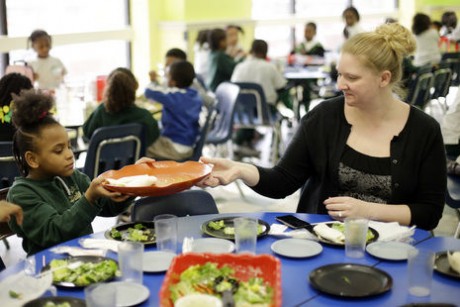 Food and meals are cultural, political, and overall human experiences. Children are often taught in schools and in their community that food is something to be consumed quickly and efficiently. However, if we consider food as something to be savored, and meals something to be enjoyed, then we define “good food” differently. This is the sort of mindset that has been missing in how we feed children. A shift in societal mindsets may just be the key to feeding kids well.
Food and meals are cultural, political, and overall human experiences. Children are often taught in schools and in their community that food is something to be consumed quickly and efficiently. However, if we consider food as something to be savored, and meals something to be enjoyed, then we define “good food” differently. This is the sort of mindset that has been missing in how we feed children. A shift in societal mindsets may just be the key to feeding kids well.
Food today, in schools and homes, is oftentimes unhealthy, quickly consumed, and utilitarian in nature (even being produced in a factory in many cases). Educating children about what healthy and sustainable food is, what “good” food is (or should be), may be the key. Jamie Oliver argues that we should teach every child (and family) about food. Thus, a shift in societal definitions of “feeding kids well” comes through educating children and challenging longstanding and outdated norms.
Food Education in (and out of) the Classroom
Children are often not taught in classrooms about eating healthy food or preparing meals. Even if they are, there is not usually a connection between the curriculum and the cafeteria. Moreover, many children do not know where their food comes from. If education were to connect the three (school curriculum, school cafeterias, and food sources), they would start developing a more informed understanding of a healthy lifestyle. Nutrition education is not one dimensional, and requires types of learning (hands on, etc.).
This change in education could be as simple as not using food in art projects as manipulatives, so children understand the importance of food. Cafeterias which provide school meals up to the nutritional standards children learn about in health class would reinforce what they have learned about healthy food. Initiatives, such as Farm-to-School, connect children back to their food sources, allowing children to understand the value of fresh produce by seeing the connection between how food is produced and what they consume daily. In this way, children learn about a healthy lifestyle, and start living one by understanding where their food comes from and what healthy meals taste like. As Marion Kalb, Director of the National Farm to School Program for the Community Food Security Coalition in Santa Fe argues, “If lessons in nutrition are reinforced by the availability of fresh foods in the cafeteria, if students are involved in gardening, farming, cooking, and other ‘real-life’ experiences with food, they are more likely to adopt a healthy eating style as a lifelong practice.”
Using the Body to Learn
The most powerful way children can learn about good, nutritious food  may be through taste. Food is a highly body-centric subject, something generally seen very separate from education. However, initiatives such as farm-to-school may be very impactful because healthy food is reinforced by a good taste. Kalb again argues, “But ultimately farm-to-school programs work because kids discover that fruits and vegetables can taste really good. Such programs can help children adopt healthy eating habits that will last a lifetime…” Thus, to reinforce the value of healthy food, a more experiential type of learning may be needed.
may be through taste. Food is a highly body-centric subject, something generally seen very separate from education. However, initiatives such as farm-to-school may be very impactful because healthy food is reinforced by a good taste. Kalb again argues, “But ultimately farm-to-school programs work because kids discover that fruits and vegetables can taste really good. Such programs can help children adopt healthy eating habits that will last a lifetime…” Thus, to reinforce the value of healthy food, a more experiential type of learning may be needed.
Changing Mindsets
“Romantic, yes, but mostly important, it’s about trying to get people to realize that every one of your individual efforts makes a difference.” – Jamie Oliver
While these actions in schools and communities may seem insignificant, they are creating changes in society. US federal policies, such as Michelle Obama’s “Let’s Move!” campaign reflect that change. There are certainly many difficulties in changing schools’ and society’s outlook on food. For example, implementing a farm-to-school program involves collaboration on all levels between students, food service directors, administration, food services staff, the community, and the government which funds the program. In this sense, changing mindsets on foods effectively takes place on all levels (schools, communities, and societies).
However, the first change comes in an individual simply recognizing flaws in a system and pushing for a different way of looking at food.
Further Reading
National Farm to School Network
Information:
http://www.nature.com/ejcn/journal/v57/n1s/full/1601824a.html
https://bobcat.militaryfamilies.psu.edu/sites/default/files/placed-programs/farm%20to%20school%20programs.pdf
http://0-www.jstor.org.luna.wellesley.edu/stable/41058190?
http://0-www.jstor.org.luna.wellesley.edu/stable/25762964?
Images:
http://archive.azcentral.com/food/free/20130227healthy-family-style-school-lunch.html
http://www.projectbread.org/news-and-events/spotlights/spotlight-details/spotlight-on-massachusetts.html?referrer=https://www.google.com/
http://edibleportland.com/2014/09/a-new-day/
